Menu
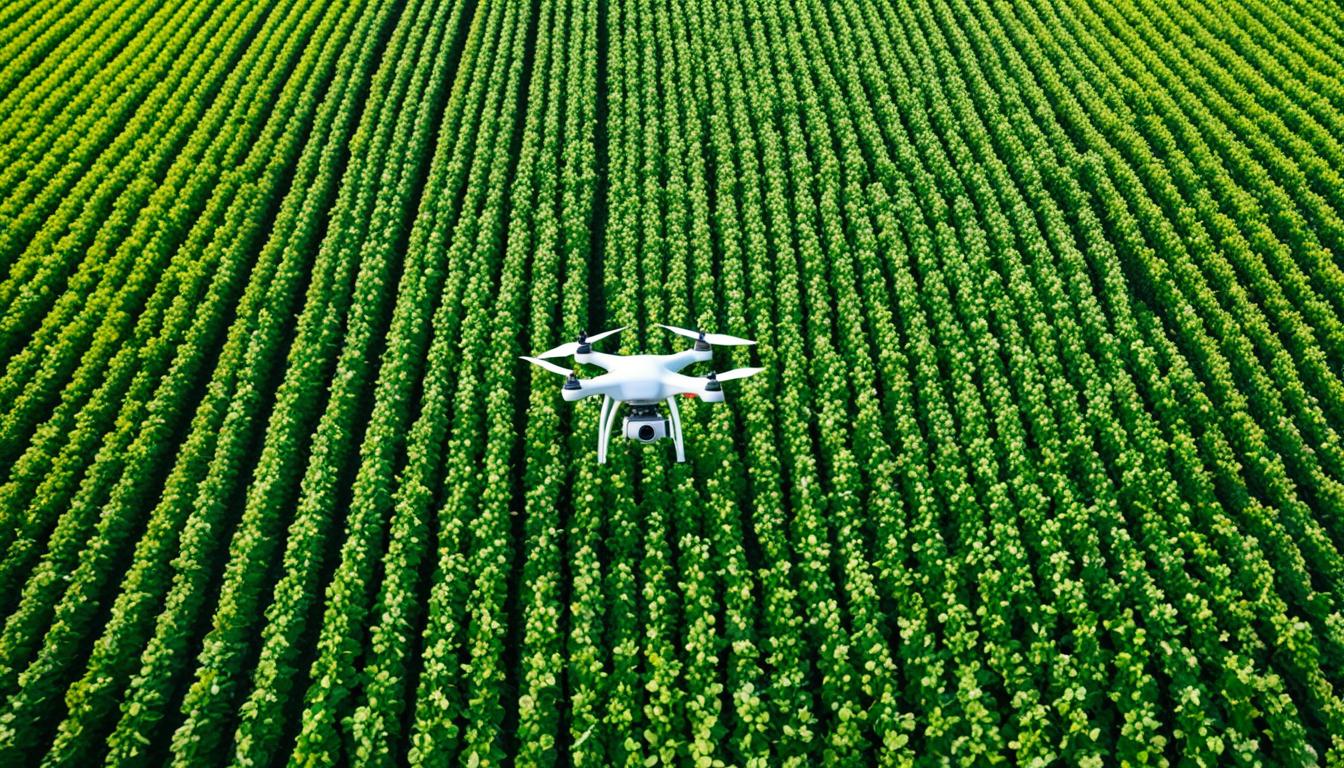
Did you know the agricultural drone market is set to jump from a $4.17 billion value in 2022 to $18.22 billion by 2030? Drones, or unmanned aerial vehicles (UAVs), are changing farming. They offer detailed insights into crop care. This growth shows how important UAVs have become in farming.
Drones help farmers monitor crops closely by giving them aerial images and data. This type of ‘precision agriculture’ improves how crops are managed. Such systems can increase crop yields by up to 5%. This is a big benefit in an industry usually looking for small profit increases. In South Korea, 30% of agriculture spraying is done with drones, showing a real-world success story.
With drones, farmers can check on parts of their fields that are hard to reach. This makes it easier to look after crops well and spot diseases early. Using drones in this way can increase crop yields by up to 25%. Drones also make farming more sustainable by cutting down on chemical use. They target only areas that need treatment, reducing chemical use by 35%. This helps save resources and cut pollution.
The use of drone technology in agriculture is a big leap for farms. These devices can fly and take pictures from above the fields. They use remote sensing to see what’s going on in the crops and the soil.
In the past few years, the agricultural drone market has boomed. It’s grown from a $1.2 billion business in 2019 to an estimated $4.8 billion by 2024. This quick growth shows how drones are changing farming for the better.
Drones are very good at seeing things up close. They can get closer to the fields than even satellites. This means they can show farmers exactly where and what help their crops need.
Drones with special sensors can tell how healthy the soil is, especially the nitrogen levels. These sensors can spot diseases in the crops before they spread too much. Less disease means crops can grow better, sometimes up to 25% more.
But using drones in farming isn’t the same everywhere. Countries have different rules. For example, South Korea uses drones for 30% of their spraying. Yet, in Canada, drone sprayers aren’t allowed because of worries they could spread chemicals too far. This shows we still need to agree on some rules and keep checking how drones can help in farming.
Drone technology has led to huge advancements in farming. This has helped the agricultural drone market grow rapidly. It’s valued at $4.17 billion in 2022, and it’s expected to jump to $18.22 billion by 2030. This growth shows farming is moving towards more technology. The agricultural drone market is one of the world’s fastest-growing sectors.
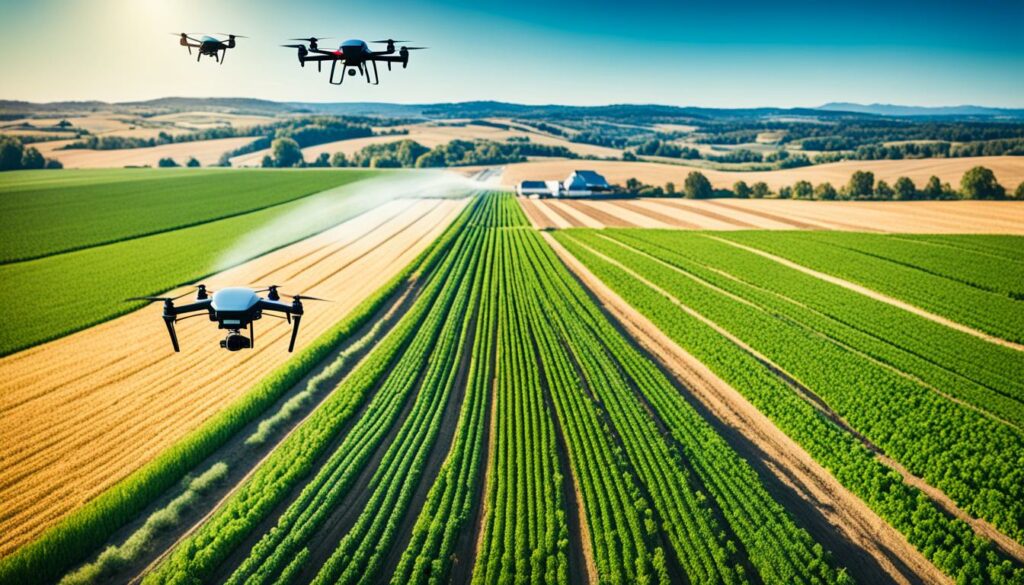
Drones are making a big impact in farming. The market went from $1.2 billion in 2019 to an expected $4.8 billion by 2024. Drones can cover up to 500 acres in a day, saving 90% of the time compared to traditional methods. This massive time-saving is encouraging more farmers to use drones.
Drones help both small and large farms. Fixed-wing drones are great for big farms because they can fly for a long time. Multirotor drones are better for close-up work, with their precise flying abilities. This flexibility helps the drone market grow for all types of farms.
For precision agriculture, drones can increase crop yields by up to 5%. They also reduce fertiliser and pesticide use by 30%. This cuts costs and helps the environment. Plus, drones can spot diseases early on, which can increase crop yields by 25%. This shows how important drones are for farm efficiency.
Globally, farmers are using drones more and more. Some models can fly up to 480 minutes and cover 200km. This versatility means drones can help with many farming tasks, no matter the size of the farm.
New drone technologies are always emerging, like drone pollination. These developments keep the agricultural drone market exciting. With more uses and better technology, drones are becoming a permanent part of farming’s future.
Using drones in agriculture has many upsides. It makes farming both more efficient and better for our planet. It helps in several important ways.
Drones greatly boost how farms are run. They can cover a lot of ground quickly. This cuts down on work needed and lowers the need for human effort. Drones are key to meeting the growing demands for food. This is shown by how the drone market in agriculture has grown.
Drones are changing how we farm by giving us real-time data. They show us the health of crops, soil quality, and parts of fields that need attention. This information helps farmers make smart choices, improving how they take care of their crops. In a huge country like India, with over 140 million farmers, this technology is very helpful.
Drones help save money by using resources more wisely. For example, they can apply pesticides very precisely. This cuts down on wasted chemicals and saves the farmer money. In places like India, where small farmers are common, drones are becoming more affordable. There, initiatives like the Kisan Drone Spray Scheme are making drones more available.
Drones revolutionise how we manage crops. They watch over fields all the time. With special cameras, they can spot problems like not enough nutrients or pests early. Finding issues quickly means farmers can keep their crops healthy and productive. This is a big win for farming of all sizes.
Drones also benefit the environment. They use chemicals more carefully, which reduces the risk of pollution. They also help farmers deal with changing weather. This makes farming more environmentally friendly and sustainable. Drones play a critical part in the future of farming by protecting our planet.
Precision agriculture uses IT to improve farming. It helps increase crop yields and lower waste. Drones play a key role by making farming more precise and efficient.
Precision farming involves checking the soil and crops, applying inputs where needed, and making decisions with data. Drones help by providing real-time images and analysis from above. This helps farmers use their resources better.
Drones are crucial for precision agriculture. They gather highly accurate data. This data is used for important tasks:
| Key Metrics | Data |
|---|---|
| GVA by agriculture (India, FY20) | 19.48 lakh crore (US$ 276.37 billion) |
| Growth in GVA | 4% in FY20 |
| Accuracy in crop predictions | 97% |
| Coverage of mines by Equinox’s drones | 4000+ hectares |
| Accuracy increase in yield tracking | 10% |
By 2050, the world will need up to 98% more food. Drones with precision agriculture can help meet this demand. They offer more detailed monitoring and better data collection. This means more consistent, higher yields for farmers everywhere.
Agricultural drones are changing how modern farming works. These high-tech UAVs help with many tasks like making maps precisely, keeping an eye on plant health, checking out soil, and watching crops from the air in real time. This technology makes looking after crops and checking on livestock health easier and more effective.
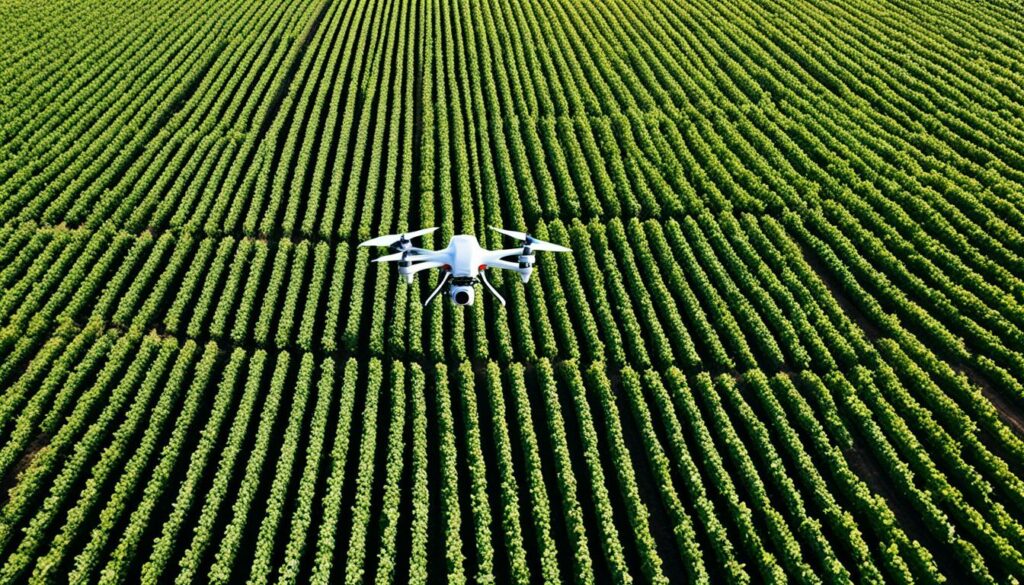
Precision mapping and surveying with drones mean farmers get very detailed looks at their land. This includes checking on crops with drones closely. Such surveys let them measure and map lands well, spotting areas where soil and plants might need help. With this detail, farmers can water and add fertiliser just where it’s needed for the best harvests.
Drones keep a close watch on how healthy plants are by taking detailed aerial photos. These photos can show if plants are stressed, have pests, or are sick. With this information, farmers can act fast to prevent big problems, leading to better crops and more food. In South Korea, about 30% of crop spraying is done with drones, which shows how well they work on big farms.
Knowing the health of the soil is key to farming sustainably, and drones with special sensors can figure it out. They can measure how wet, salty, or full of nitrogen the soil is. Using this important information, they help farmers plan the best ways to water and fertilise, which makes the farm more green and efficient. This careful soil check can even boost crop growth by 5% using smart farming techniques.
Drones that can watch fields from above in real time give farmers the power to see a lot in a short time. This quick and constant eye on the land means any issues like too much or too little water, or strange crop patterns, can be spotted fast. Drones take photos from high up, helping farmers keep a very current picture of what’s going on the farm. This helps with how the farm is run in general.
Drones are also really useful for checking on animal health. They can fly up and give a full view, letting farmers check on animals, see where they move, and review the state of the grass. This way, farmers can make sure that their animals are well looked after, quickly spotting any injuries or sickness. Using drones for this kind of work means farms run better, with animals being looked after well and more productivity.
Integrating advanced agricultural techniques into drone crop monitoring has made big steps in farming. It allows for better crop health pictures and data review. This new way is great at finding crop health problems early. So, farmers can fix things before they become big issues.
Precision farming with drones can increase crop yields by up to 5%. This is important because farming often doesn’t make a lot of money. Drones use NDVI imaging to see crops in great detail. This helps with better crop care. Drones do a better job than satellites at seeing issues. This is very helpful in knowing when to replant or if there are any problems with the crops.
Drones also check the height of the land to find any irregular spots. This knowledge helps to water fields better and makes the soil healthier. So, drones do more than just watch over the land. They help make sure it’s in good shape too.
These high-tech tools are changing farming for the better. More and more drones are being used in farming. In fact, the drone farming market is expected to grow from $1.2 billion in 2019 to $4.8 billion in 2024.
| Feature | Benefit | Statistic |
|---|---|---|
| Precision in Replanting | Improved crop management | Millimeter accuracy of drones compared to meter accuracy of satellites |
| Elevation Mapping | Efficient watering and better soil health | 30% increase in efficiency for agricultural spraying in South Korea |
| NDVI Imaging | Early detection of crop health issues | Boosts yields by up to 5% |
| Market Growth | Increased adoption of advanced techniques | $1.2 billion (2019) to $4.8 billion (2024) |
To sum up, using advanced farming with drones is a game-changer. It allows for caring for crops accurately and on time. This leads to better crops and farming that’s kinder to the earth.
Agricultural drones are now vital for modern farming. They boost efficiency and precision in many tasks. Two key types are fixed-wing drones and multirotor UAVs. Each has its own benefits, suiting different farm needs.
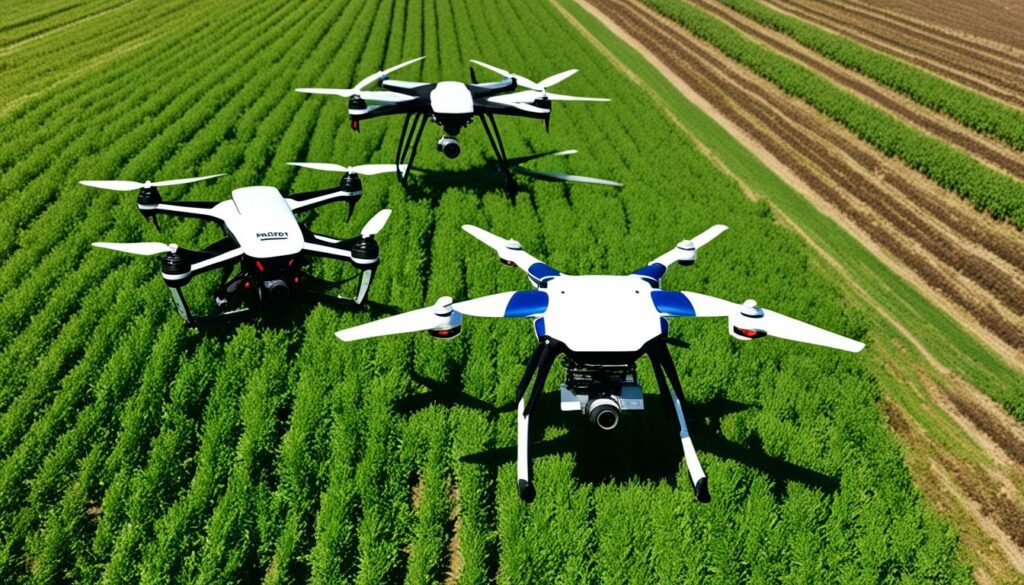
Fixed-wing drones cover large areas of farmland quickly. They look like normal planes but work very differently. They use less energy and can fly over 500 acres in a day. This makes them perfect for big farms. Also, they save time and resources with their long flight times and high speeds.
Multirotor drones, like quadcopters, are great for close-up work. They can hover and move precisely, making them ideal for detailed inspections. They work well for keeping an eye on crop health, finding pests, and spraying fields accurately. With their smart sensors and cameras, they help farmers use resources better and improve farm techniques.
Both types help agriculture be more productive and earth-friendly. Fixed-wing drones are good for vast areas. Multirotor drones shine in small, focused tasks. As the drone market grows, their use in farming will become even more vital. These drones help farms produce better and use resources wisely.
| Drone Type | Key Features | Applications |
|---|---|---|
| Fixed-Wing Drones |
|
|
| Multirotor Drones |
|
|
Choosing the right drone type helps farmers improve their crops, save resources, and be greener. Fixed-wing drones are great for big areas. Multirotor drones are the best for careful jobs. This smart use of drones helps farming get better all around.
Agricultural drones are changing the game in farm management. They’re packed with the latest sensor technology. This allows farmers to collect important data for efficient farming. They help with better monitoring of crop health and managing resources well.
RGB cameras are key for drones used in farming. They take high-quality, full-colour photos. These pictures are crucial for activities like field inspection and problem-spotting. The clear views they offer let farmers closely check their crops.
Multispectral sensors are crucial in precision farming. They can see across different light wavelengths. This kind of imaging gives a deep look into plant health and soil quality. It helps farmers spot issues like disease or lack of nutrients early. This early detection means they can act quickly to save their crops. These sensors are a big help in boosting crop output and farming more sustainably.
Infrared cameras take thermal images to show heat and water stress in crops. This technology gives insight into how much water crops need. It’s important for smart watering, which saves water and improves yields. Besides, they help in keeping plants healthy by monitoring their conditions.
| Sensor Type | Example Models | Estimated Cost | Features |
|---|---|---|---|
| RGB Camera | Sentera NIR | $2,000 | High-resolution imagery |
| Multispectral Sensor | MicaSense RedEdge-MX | $5,500 | Five bands (B, G, R, RE, NIR) |
| Multispectral Sensor | Parrot Sequoia+ | $3,500 | Five bands (G, R, RE, NIR, RGB) |
| Multispectral Sensor | SlantRange 4P+ | $4,950 | Four bands (R, RGB, RE, NIR) |
| Multispectral and Thermal Sensor | MicasSense Altum | $10,000 | Six bands (B, G, R, RE, NIR, Thermal) |
| Hyperspectral Sensor | Nano-Hyperspec | Not Provided | Captures data within 400 – 1000 nm range |
Drones are vital in watching plant health. They use high-tech tools to protect crops and help them grow best. NDVI technology is a key player in this. “NDVI” stands for Normalized Difference Vegetation Index.

NDVI sensors are crucial. They measure how much light plants bounce back. This helps check their health. By comparing near-infrared to red light, farmers can learn a lot. They see if plants are stressed, lacking in nutrients, or getting sick early.
Drones are great at finding crop diseases early. With NDVI, farmers can see possible diseases before they show up. This quick look saves crops. It lets farmers act fast. Using thermal cameras and other tools makes watching plant health even better.
Knowing the soil and field conditions well is key for farming today. Drones are changing how farmers work, giving them in-depth data and the power to make choices based on facts. They are a must-have for keeping an eye on soil health, a fundamental part of sustainable farming.
Drones help us understand the land’s shape from above. They use special sensors to map out the ground in fine detail. These maps are vital for laying out drainage systems that work well and keeping the ground from washing away. Plus, farmers can use the data to water their fields just right.
Figuring out how much moisture and nitrogen the soil has is key. Drones with Multispectral cameras can spot changes in these levels. This information is up to date, so it tells farmers when and where to water, saving water and keeping crops healthy. With this tech, farmers can increase what they grow and how good it is.
The use of drones in agriculture has grown rapidly. It has changed the way farms are managed. Farmers can now look after their crops better thanks to drones. These flying gadgets give them detailed views of their fields. This allows for better farming decisions.
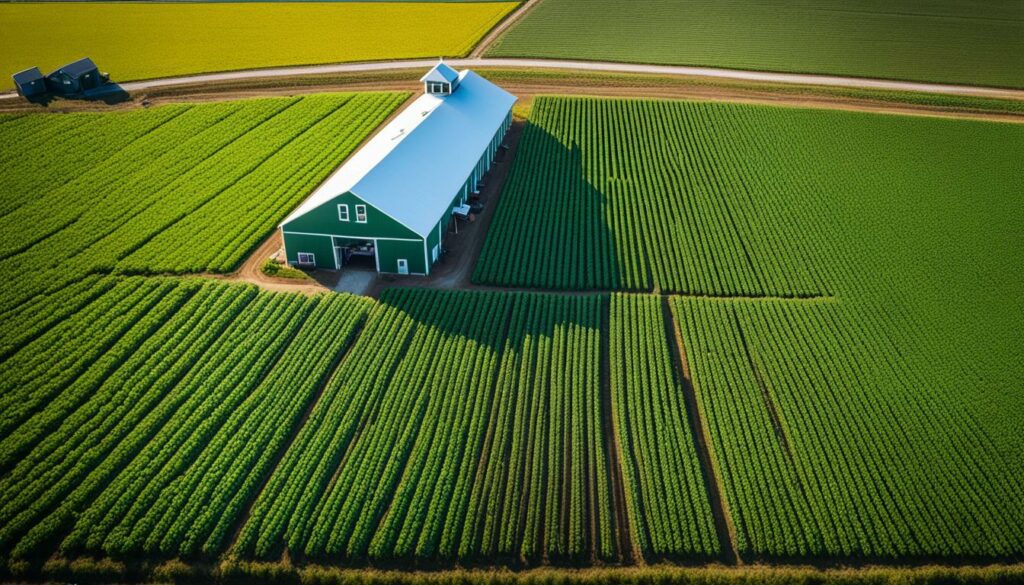
One key job for drones is spotting pests. They do this job better than the old methods. With special cameras and sensors, drones can find pests quickly. This lets farmers act fast. They can protect their crops using fewer chemicals. This helps the environment too.
Drones are great at managing water on fields. They can find places where water collects. This is important because it can harm crops. With up to 500 acres covered in a day, drones give a big picture. Farmers can then fix problems fast. This smart use of technology makes farm water use better. It leads to healthier crops.
Drone seeding tech is changing how we plant trees and crops. It was worth $1.2 billion in 2019, and by 2024, it’s expected to reach $4.8 billion. One standout area is in using drones for planting with great precision.
Recent tests with this technology have been amazing. Picture this: just two people working ten drones could plant 400,000 trees in one day. This kind of efficiency means big advances in planting and much less hard work for people. Drones are quick and accurate, which is why they’re making such a big impact on reforestation and farming on difficult land.
Studies show that using drones to plant is very effective. Take the JOUAV CW-15, for example. It can do the work of fourteen multi-rotor drone flights. This shows how using drones cuts costs and saves resources. They’re quickly becoming a key part of how we farm today.
Using drones for planting can change farming in a big way. As we keep improving and investing in this tech, we can do planting much better. So, drones are leading us into a new world of farming that’s both high-tech and friendly to the planet.
Drone sprayers have changed how we apply pesticides and fertilisers. They can reach places that are hard to get to. They also hit the target better, which makes farming treatments more efficient and effective.
Drone sprayers can go where other machines can’t, like steep areas. They can do this very accurately, using less treatment. This means saving money and helping the environment. They can cover up to 40 hectares a day, depending on various factors.
“The agricultural drone market is expected to grow from a $1.2 billion(USD) industry in 2019 to $4.8 billion in 2024.”
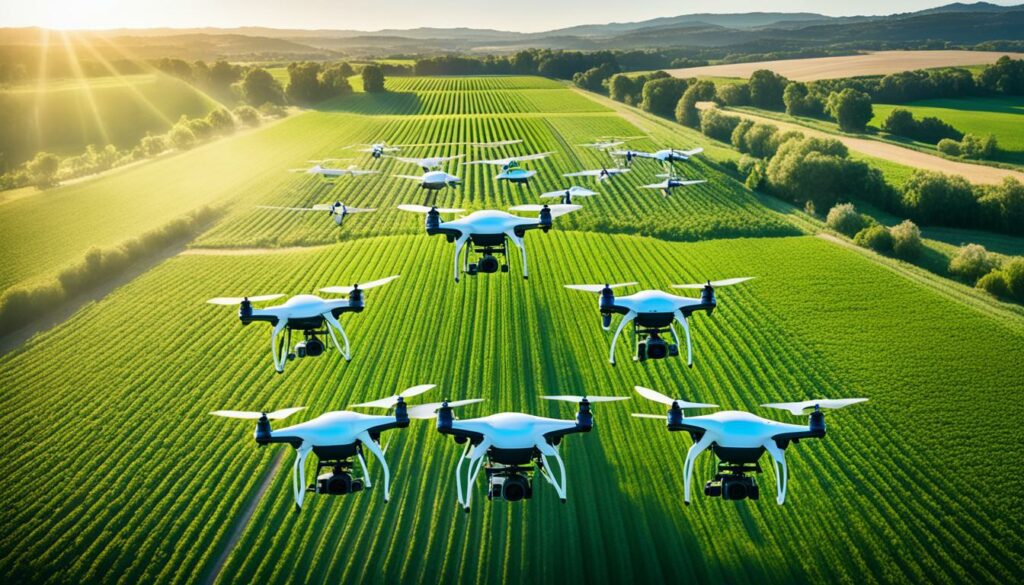
Although drone sprayers offer many benefits, they also face several challenges. Rules about using drones and spraying vary from place to place. Weather conditions and spray drift are also concerns. Despite this, technology is improving, and more places are using drones for farming. For example, South Korea uses them for 30% of their agricultural needs.
| Drone Model | Application | Advantages |
|---|---|---|
| DJI Agras T40 | Fertilisers & Pesticides | Integrated spraying systems, affordable |
| Quadcopters | Crop fertilisation | Multi-rotors for precision |
| Fixed-Wing Drones | Large field coverage | Requires large take-off space |
The future of drone sprayers is bright. AI and better technology will make them even more efficient and accurate. Solving current challenges and improving rules can change how we treat crops. This could lead to better productivity and care for the environment in farming.
Protecting farm assets with drones is now more crucial than ever. Drones give farmers a full aerial view of their farms. They watch over daily work and keep valuables safe.
Farmers can now watch their land live thanks to drone security. Drones fly over fields, capturing clear images with their cameras. This helps keep a close eye on the farm’s activities.
Real-time data from drones quickly spots any issues. Farmers can then act fast to fix things.
Drones play a big part in keeping crops and livestock safe. By flying over fields, they check crop health and watch for dangers. They also target apply treatments, saving on costs.
For livestock protection, drones track where the animals are. This ensures their safety. If there’s a threat, farmers know right away and can react fast. This keeps their farms running smoothly.
Looking at drone success stories helps us see how drones improve farming. They range from making forest management better through 3D mapping with drones to making crop checks more efficient. This shows how drones can truly change the game in agriculture.
Drones are changing how we look after forests. By making 3D point clouds, drones help us see the forests’ structures and health. This makes it easier to watch how trees grow, spot diseases fast, and plan smart cuts. The info drones gather helps save resources and improve how we manage forests.
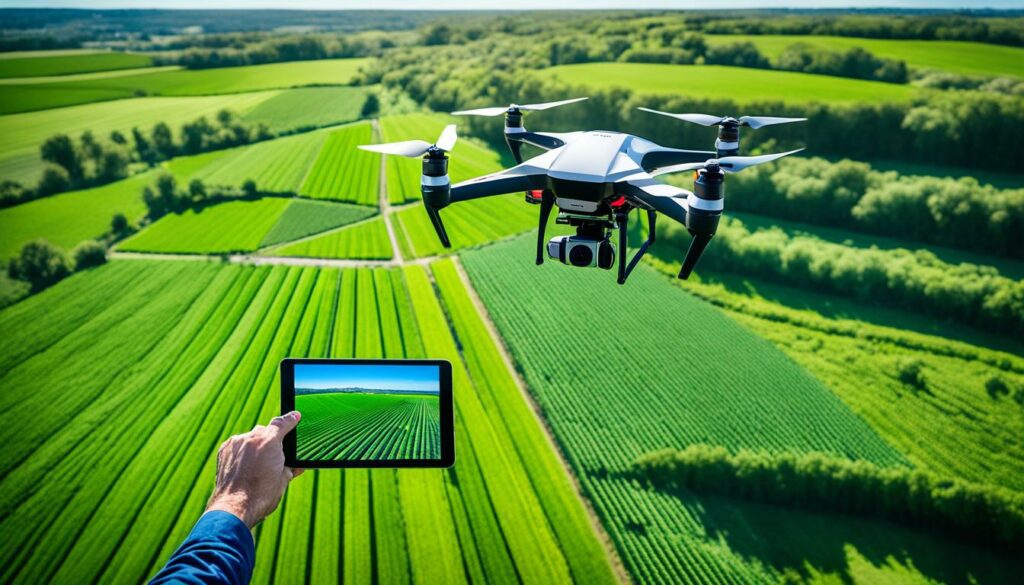
Drones are a big help in watching over crops better. They can check up to 500 acres a day, saving farmers time and hard work. Using the data they gather, farmers can lower their use of harmful chemicals by up to 30%. This saves money and the planet. Also, spotting diseases early with drone images can increase harvests by up to 25%. This shows how much drones can help in farming.
In Sanjiangyuan, drones are vital for watching over nature. They give us high-quality aerial pictures and data. This helps keep track of how the area changes because of the weather or people. Sanjiangyuan, called the “Water Tower of Asia,” really benefits from drones. They help with accurate info for better conservation and land use.
These stories show the big plus of drone tech in farming today. With tools like 3D mapping with drones, farmers and nature protectors do way more. They change old ways of doing things and make a greener future possible.
Getting the right drone is key for better farm management and more productivity. You should look at what your farm needs, like its size and the crops you grow. I’m here to help you pick from the top drone models that are perfect for farming.
Finding the best drones is a major step in this guide. Take the DJI Mavic 3M, for example. It has a 20MP RGB camera and four 5MP multispectral sensors for detailed data and crop checks. It can fly for up to 43 minutes and cover 200 hectares each time, making it a leading choice.
The eBee AG by AgEagle Aerial Systems is another top pick. It has dual cameras and can fly for 55 minutes, covering 395 acres in a go. Also, it follows the rules and can fly BVLOS (Beyond Visual Line of Sight), which is a big deal in drone use.
| Feature | DJI Mavic 3M | eBee AG |
|---|---|---|
| Camera System | 20MP RGB + Four 5MP Multispectral | Dual RGB and Multispectral |
| Flight Time | 43 minutes | 55 minutes |
| Coverage | 200 hectares per flight | 395 acres per flight |
| Compliances | – | BVLOS, Flights Over People |
To choose the best drone, look at several things for good results and less cost. Think about:
This guide helps you choose the right drone for your farm. It aims to boost how well your farm runs and its productivity with the best drone technology available.
Using drones in farming must meet safety rules. Knowing and obeying local laws is key. Laws differ based on why you fly and the drone’s design. This keeps all safe and the area protected.
Operating drones legally means following a lot of rules. This includes signing up your drone, sticking to how high it can go, and getting the right permissions for business use. Knowing the rules from start to finish helps you fly legally and smoothly.
In Europe, groups like EASA and EUROCAE set safety rules. They were made after the European UAS Standards Coordination Group made over 800 rules for drone tech. Partnerships like EUROCAE and JARUS help with advice on tech, safety, and how to fly drones safely in the sky.
Staying safe with farm drones means always following the rules and keeping them in top shape. Drones need high-tech sensors and ways to avoid hitting things. Checking them and their safety often helps stop problems. The FAA helps by okaying drone flights in certain areas. This makes flying drones safer and easier.
Drones work best in temperatures between 14°F and 100°F. Having someone watch complex tasks makes them safer. Knowing these tips makes using drones in farming not just safer but more useful.
| Region | Regulatory Body | Key Standards |
|---|---|---|
| United States | FAA | Part 107, LAANC |
| European Union | EASA, EUROCAE | Certification, Operational Limitations |
| Global | JARUS | Technical, Safety, and Operational Guidelines |
The agriculture drone sector is about to change in big ways. This change comes from the growth of artificial intelligence, machine learning, and self-driving technology. These high-tech drone applications promise a bright future for accurate farming.
One big change coming in agriculture drones is AI and machine learning. These technologies allow drones to use up-to-the-minute data to spot patterns and make forecasts. This helps in decision-making.
Take the example of drones with special cameras and sensors. They can find weeds and zap them with lasers. This method cuts down on using harmful chemicals. It’s better for the environment.
Autonomous drones are making farming more efficient than ever. They can do their jobs without people involved. As more places allow their use, farmers of all sizes can use this technology. This means more farm work gets done at a lower cost, while also being kinder to the planet.
The future looks full of new and clever ways to use drones. Fixed-wing drones, which are good for covering large areas and don’t cost much, are in demand for bigger farms. Drones as a Service (DaaS) is a new option that lets farmers rent the tech they need without a huge upfront cost. This makes fancy drone tech easier to get for farms of all sizes.
Competition between new companies is also driving down prices and sparking change. All these advances make farming more efficient and help protect the environment.
| Trend | Description | Benefits |
|---|---|---|
| AI and Machine Learning Integration | Utilising AI to process data and predict patterns. | Enhanced decision-making, precision targeting of weeds. |
| Autonomous Drone Technology | Deploying drones that operate independently. | Increased efficiency, cost reduction, reduced environmental impact. |
| Innovative Use Cases | New applications such as DaaS and fixed-wing drones. | Greater accessibility, cost-effectiveness, competition-driven innovation. |
This new era is promising. It envisions AI-driven farming, autonomous drones, and more, changing agriculture for the better. Governments are stepping in to help this growth. They see how these technologies can boost economies and jobs.
Drones have changed farming by making it more efficient and effective. They use cameras to spot crop issues early, helping farmers act fast and use fewer chemicals. This leads to crops that are healthier and more abundant.
By flying over fields, drones create detailed maps. These maps show farmers where to exactly apply water, fertiliser, and how to control pests better. This improves how resources are used and the quality of the crops.
Using drones means less work and cost for farmers. They can quickly cover large areas without the need for lots of people. It doesn’t matter how big or small the farm is – drones can help. They are making farming more productive, sustainable, and profitable.
Drones are equipped with UAV technology for farmers. They provide aerial images and data. This helps in monitoring plant health, detecting pests. They also assess soil conditions to improve decision-making.
Drone technology is essential in agriculture today. It uses UAVs for remote sensing and collecting data. This method captures aerial imagery for crop health and soil conditions. It improves farm management and productivity.
The agricultural drone market is growing fast. Driven by more drone use in farming tasks, it includes surveying and crop monitoring. This growth spans from small-scale farms to large enterprises. It shows drones’ wide application and future potential.
Drones bring many benefits to farm work. These include more efficient work, better decisions through data, and saving money. They help manage crops better, work with the environment, and promote sustainable farming.
In precision agriculture, drones are key. They help with accurate mapping and crop scouting. This helps farmers use their land better. It can improve crop yield and reduce waste.
Drones use methods like precision mapping and surveying. They monitor plant health and soil, and provide real-time surveillance. They’re also useful in tracking animal health and pastures from above.
New methods include advanced imaging and data analysis. These technologies find crop health issues early. Farmers can react quickly to keep their crops healthy. This reduces damage from pests and diseases.
Agricultural drones come in fixed-wing and multirotor types. Fixed-wing drones are great for covering large areas fast. Multirotors, like quadcopters, are more agile. They suit smaller areas and detailed inspections.
Drones use various sensors and cameras for farm data. These include RGB cameras for images, multispectral sensors for plant health, and infrared cameras for heat and water stress.
NDVI technology is a common method. These sensors measure the health of plants. They provide data for early disease detection. This helps protect the crops.
Drones check soil and field conditions with detailed maps. They look at moisture and nitrogen levels. This data helps in specific irrigation and nutrient needs. It makes sure the soil is good for crops.
In scouting, drones help spot pests and water issues. This info leads to proactive pest control and better water use. It reduces damage to crops.
Drone planting and seeding drops seeds from the air. It’s useful in hard-to-reach areas and cuts labour needs. This method boosts reforestation and farming practices.
Drone sprayers can reach tough spots and apply sprays accurately. Challenges include rules and spray drift issues. But, technology is progressing, offering better ways to treat crops.
Drones improve farm safety by watching over the land. They track equipment, crops, and animals. This helps in managing the farm better, preventing theft and keeping animals safe.
Examples include better forest management and crop monitoring in Sanjiangyuan. Drones have a big impact on farming, environmental monitoring, and more. They’re making a difference in many ways.
To pick the best drone, think about your farm’s size and needs. Look at different models and features. Also, consider your budget and what you want to achieve with the drone.
Follow the local laws on drone use, which depend on the drone’s features. Learn all safety rules and keep your drone in good shape. This avoids accidents and legal problems.
The drone industry will see more AI and autonomous drones. This will open up new farming uses for drones. They will become even more important in agriculture in the coming years.